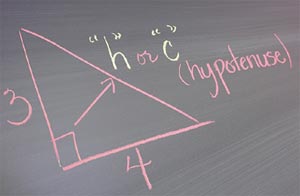 Trigonometric functions are often used in technical subjects
such as natural resources. Of particular importance is their use in
land surveying and in measurements.
Trigonometric functions are often used in technical subjects
such as natural resources. Of particular importance is their use in
land surveying and in measurements.
The fundamental concept behind trigonometry is the angle. An angle is a measurement of the amount of rotation between two lines. Angles are commonly measured in degrees or radians.
For now we will focus on understanding degrees, minutes and seconds. Angles work similar to the way our time system works. That is a degree (°) is divided into 60 minutes (‘) and a minute is divided into 60 seconds (“). We can write this as DMS ° ‘ “. We can also express the DMS as a decimal.
Example
Lets work through a problem converting between DMS to decimal degrees:
Convert the following: 28° 15’ 23”
To solve this problem we do not have to do anything with the degrees since they are a whole number.
Next we need to convert 15’. To do this you start by dividing 15 by 60. Remember 1 degree has 60 minutes. So we get an answer of 0.25.
Next we need to convert 23” into degrees. To do this we first need to know how many seconds are in a degree. Remember there are 60 minutes in a degree and 60 seconds in each minute. So 60 x 60 will tell you how many seconds are in a degree. You should have gotten 3,600. So now we need to divide 23” by 3,600. You should have gotten 0.00639.
Last we add up each part:
28 + 0.25 + 0.00639 = 28.2564°
Example
Now let’s try converting from decimal degrees back to DMS
Convert 36.39° to DMS
Let’s start with the obvious we do not need to do anything with the whole number of degrees. 36° = 36°
So the next step is to find out what 0.39 of 1° is. To do this we multiply 0.39 by 60’. You should have gotten 23.4’ for answer. This means we have 23’ and 0.4 of a minute left over. So now we have to convert 0.4 minutes into seconds. To do this you multiply 0.4’ by 60” and you get 24 seconds.
So putting this altogether gives you:
36° 23’ 24”
| LESSON 3 |


